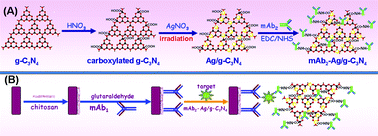Silver-functionalized g-C3N4 nanohybrids as signal-transduction tags for electrochemical immunoassay of human carbohydrate antigen 19-9
Abstract
A simple and feasible electrochemical immunosensing platform was developed for highly efficient screening of a disease-related protein (human carbohydrate antigen 19-9, CA 19-9 used in this case) using silver-functionalized g-C3N4 nanosheets (Ag/g-C3N4) as signal-transduction tags. Initially, Ag/g-C3N4 nanohybrids were synthesized by combining thermal polymerization of the melamine precursor with the photo-assisted reduction method. Thereafter, the as-synthesized Ag/g-C3N4 nanohybrids were utilized for the labeling of the anti-CA 19-9 detection antibody by using a typical carbodiimide coupling method. The assay was carried out on a capture antibody-modified glassy carbon electrode in a sandwich-type detection mode. The detectable signal mainly derived from the voltammetric characteristics of the immobilized nanosilver particles on the g-C3N4 nanosheets within the applied potentials. Under the optimal conditions, the voltammetric peak currents increased with the increasing amount of target CA 19-9, and exhibited a wide linear range from 5.0 mU mL−1 to 50 U mL−1 with a detection limit of 1.2 mU mL−1. Our strategy also displayed good reproducibility, precision and specificity. The results of the analysis of clinical serum specimens were in good accordance with the results obtained by an enzyme-linked immunosorbent assay (ELISA) method. The newly developed immunosensing system is promising for enzyme-free and cost-effective analysis of low-abundance proteins.


 Please wait while we load your content...
Please wait while we load your content...